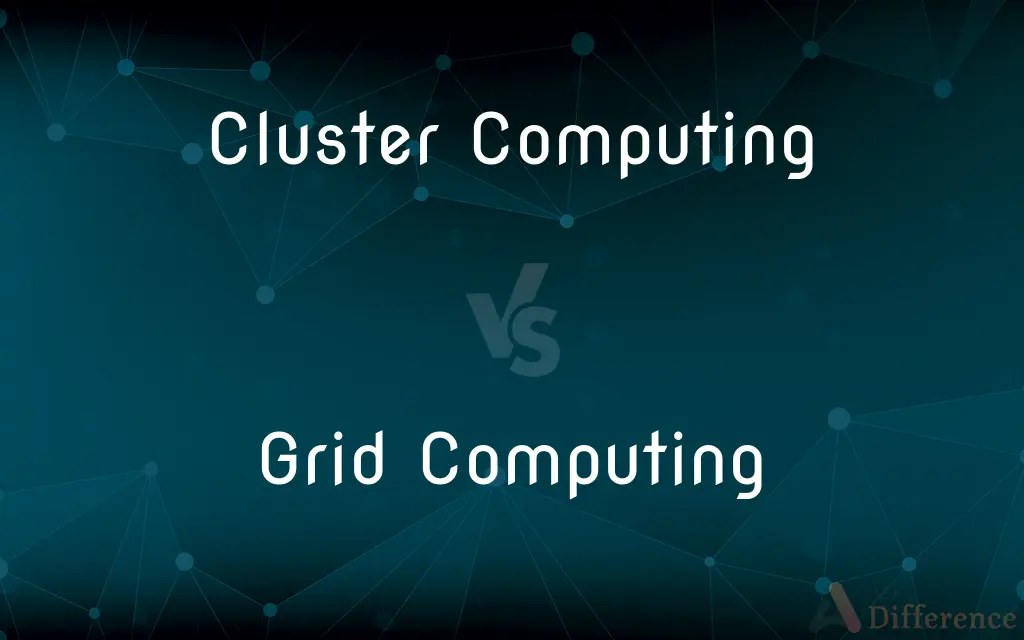Cluster Computing vs. Grid Computing — What's the Difference?
By Tayyaba Rehman — Published on January 8, 2024
Cluster computing involves tightly connected computers working together as a single system, while grid computing involves distributed, loosely connected computers working on shared tasks.

Difference Between Cluster Computing and Grid Computing
Table of Contents
ADVERTISEMENT
Key Differences
Cluster computing and grid computing are two approaches to harnessing the power of multiple computers to perform complex tasks. Cluster computing involves a set of closely linked computers, often located in the same geographical location, working together as a unified computing resource. These computers are connected via high-speed local area networks and operate as though they are a single system. Cluster computing is often used for tasks that require high computational power, such as scientific simulations, data analysis, and processing large amounts of data.
Grid computing, on the other hand, involves a collection of computers, often spread across multiple locations, connected via the internet or other wide-area networks. These computers work together to perform large-scale tasks, but unlike cluster computing, the machines in grid computing are more loosely connected and may belong to different organizations. Grid computing is often used for projects that require a large amount of distributed computing power, such as analyzing vast datasets, complex simulations, or processing tasks that can be easily divided and distributed among many computers.
Cluster computing offers the advantage of high-speed connectivity and consistent performance, as the computers are closely linked and usually have similar configurations. Grid computing, however, offers greater flexibility and scalability by allowing a wide variety of computers to contribute processing power, but may face challenges in terms of connectivity speed, security, and data integrity.
Both cluster computing and grid computing play crucial roles in modern computing, enabling the processing of large-scale tasks that would be impossible for a single computer to handle. While cluster computing offers a more controlled environment with potentially higher performance, grid computing offers greater scalability and resource sharing across different locations and organizations.
Comparison Chart
Connection
Tightly connected
Loosely connected
ADVERTISEMENT
Location
Usually in the same geographical area
Spread across multiple locations
Resource Sharing
Limited to cluster members
Broad, often involving multiple organizations
Scalability
Scalable but within certain limits
Highly scalable, can add diverse resources
Typical Use Cases
Scientific simulations, data analysis
Large-scale distributed projects, data-intensive tasks
Compare with Definitions
Cluster Computing
It's characterized by tight integration and high-speed local network connections.
The company's cluster computing setup ensured rapid data processing.
Grid Computing
It's characterized by wide-area network connections and resource sharing.
The scientific team used grid computing for their large-scale genomic analysis.
Cluster Computing
Cluster computing involves a group of interconnected computers working as a single system.
The research lab used cluster computing to analyze genetic data efficiently.
Grid Computing
Grid computing involves a distributed system of loosely connected computers.
Grid computing enabled the collaborative project across various universities.
Cluster Computing
Often used for tasks requiring intensive computation and data processing.
Cluster computing was essential for the large-scale financial modeling.
Grid Computing
Offers flexibility and scalability across multiple organizations.
Grid computing facilitated the expansive climate research project.
Cluster Computing
Operates within a controlled and consistent environment.
The cluster computing environment allowed for predictable performance metrics.
Grid Computing
Ideal for distributed tasks that can be broken into smaller chunks.
The protein folding study benefited from the distributed nature of grid computing.
Cluster Computing
Cluster computing offers high computational power and reliability.
Cluster computing provided the necessary power for the complex weather simulation.
Grid Computing
Allows for the pooling of resources from various locations.
Grid computing was utilized to harness computational power from around the world.
Common Curiosities
Are computers in cluster computing geographically close?
Typically, yes, they're often in the same location.
What’s a key advantage of cluster computing?
It offers high-speed connectivity and consistent performance.
What is cluster computing?
Cluster computing involves closely connected computers working as a single system.
How does grid computing work?
Grid computing connects distributed, loosely linked computers to perform tasks.
What tasks are suitable for grid computing?
Suitable for distributed, data-intensive tasks.
Is grid computing highly scalable?
Yes, it can incorporate a wide range of resources.
Can cluster computing be part of grid computing?
Yes, a cluster can be a node within a grid.
Can grid computing span multiple organizations?
Yes, it often involves collaboration across different groups.
Can cluster computing handle diverse tasks?
Yes, but within the computational limits of the cluster.
What are typical uses for cluster computing?
Uses include scientific simulations and data analysis.
How does connectivity differ in these two systems?
Cluster computing uses high-speed LANs, while grid computing uses WANs.
Do resources in grid computing need to be homogeneous?
No, they can be diverse and varied.
Why is grid computing beneficial for collaborative projects?
It allows resource sharing and collective processing across locations.
Can cluster computing be used for large-scale projects?
Yes, but within certain scalability limits.
Is security a bigger concern in grid computing?
Yes, due to its distributed and varied nature.
Share Your Discovery

Previous Comparison
28 States vs. 8 UT
Next Comparison
Geico Car Insurance vs. Hartford Car InsuranceAuthor Spotlight
Written by
Tayyaba RehmanTayyaba Rehman is a distinguished writer, currently serving as a primary contributor to askdifference.com. As a researcher in semantics and etymology, Tayyaba's passion for the complexity of languages and their distinctions has found a perfect home on the platform. Tayyaba delves into the intricacies of language, distinguishing between commonly confused words and phrases, thereby providing clarity for readers worldwide.













































